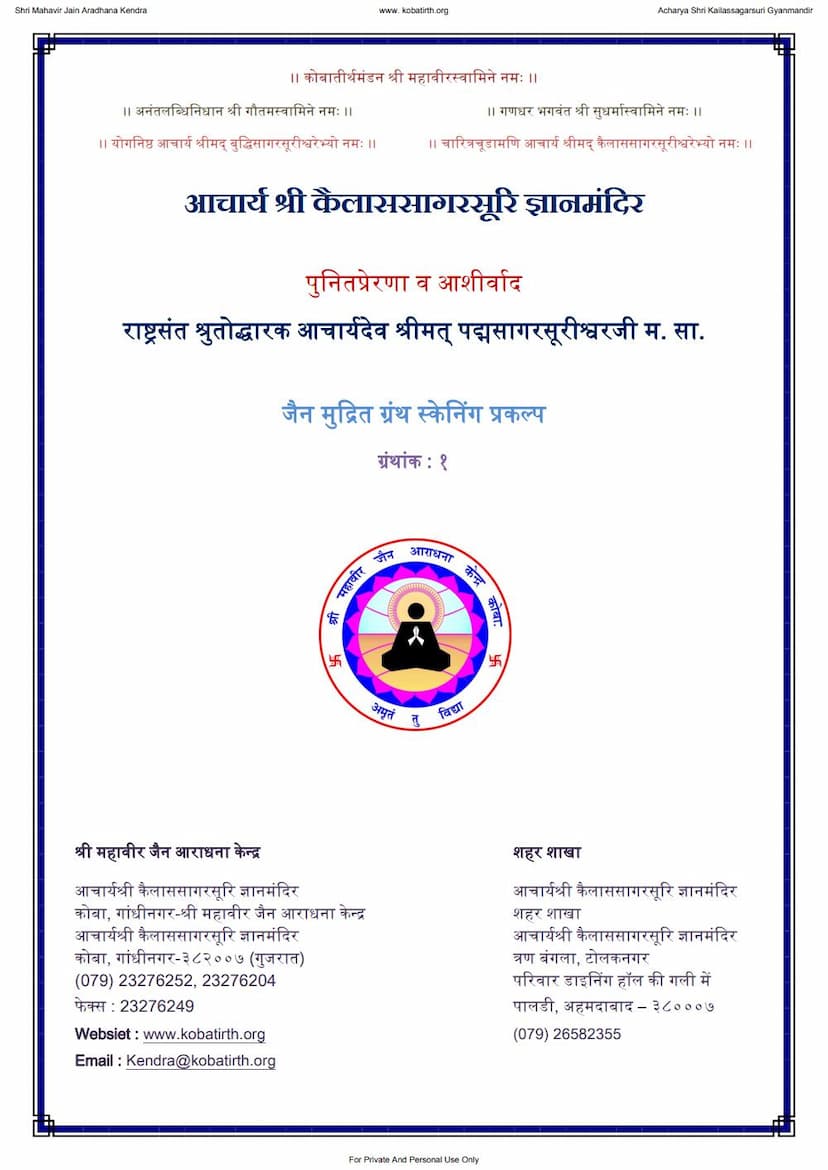Vyavahar Sutram Part 04
Added to library: September 2, 2025

Summary
Here's a comprehensive summary of the provided Jain text, "Vyavahara Sutram Part 04" by Munichandrasuri, focusing on the content from pages 10-271, which corresponds to the translation of the text from page 29 onwards in the provided document.
This volume, Part 04, of the Vyavahara Sutram, edited by Acharya Vijay Munichandrasuri, contains the commentary and glosses by Shriman Malayagiri Suri, along with the Niryukti-Bhashya. It covers Chapters 6 and 7 of the Vyavahara Sutram.
The text primarily deals with the conduct and responsibilities of Jain monks (Bhikkhu) and nuns (Bhikkhuni), particularly concerning their interactions with lay society, ethical considerations during their spiritual practice, and specific disciplinary rules.
Key Themes and Concepts Covered:
-
Navigating the World (Known as Nayavih - ज्ञातविधि):
- The text extensively details the rules and etiquette for monks visiting their relatives or known households (Nayavih - ज्ञातविधि). This includes the necessity of obtaining permission from senior monks (Thera) before visiting.
- It outlines the reasons for such visits, such as a monk's illness (Glanan) or the need for medicine and treatment.
- Various scenarios are described where visiting is permissible and the precautions to be taken.
- The text warns against visiting without proper cause and elaborates on the potential pitfalls and faults (dosha) associated with such visits, including falling prey to worldly temptations and losing one's spiritual discipline (Sanyam Viradhana).
- Detailed explanations are given on what types of food and offerings are permissible to accept and what to avoid, based on how they were prepared or offered.
-
Conduct of Acharyas and Upadhyayas:
- A significant portion of the text is dedicated to the exceptional qualities and duties (Atishaya) of Acharyas (spiritual leaders) and Upadhyayas (teachers).
- These Atishayas include performing specific actions with utmost care and purity, such as meticulous cleaning of feet upon entering a monastery, managing bodily excretions within designated areas, and performing various acts of service.
- The text emphasizes the importance of the Acharya's adherence to rules, their behavior, and their role in guiding the monastic community. It highlights their responsibility to protect the Sangha and uphold Jain principles.
- Specific instances and guidelines are provided for situations where an Acharya might need to go out, such as for alms or specific duties, and the precautions they must take.
-
Disciplinary Rules and Actions:
- The text outlines various disciplinary measures and expiations (Prayashchitta) for breaches of conduct, ranging from minor faults (Laghu) to more serious transgressions (Guru, Chheda, Parangith).
- It details procedures for admitting new members into the monastic order, especially concerning the qualifications and vetting process.
- Rules are laid out for dealing with situations of dispute or conflict within the monastic community and with laypeople.
-
Specific Situations and Prohibitions:
- The text addresses situations such as the conduct of monks and nuns when visiting homes, particularly the types of food to accept and avoid, and the potential for worldly attachment.
- It discusses the importance of maintaining proper conduct, especially when dealing with the opposite sex, even when visiting known households or during alms rounds.
- There are detailed discussions on avoiding situations that could lead to spiritual downfall (Viradhana), such as engaging in worldly conversations, accepting forbidden items, or showing excessive attachment.
-
The Nature of Karma and Liberation:
- While not explicitly a philosophical treatise, the underlying context of adhering to these rules is the purification of karma (Nirjara) and the ultimate goal of liberation (Moksha). The text implies that strict adherence to these conduct rules leads to spiritual merit and progress towards liberation.
-
The Importance of the Guru and Community:
- The text repeatedly stresses the role of the Guru (Acharya/Upadhyaya) in guiding disciples and the importance of following their instructions.
- It also emphasizes the collective responsibility of the community (Sangha) in upholding the principles of conduct and ensuring that no member falls astray.
Structure and Content:
The "Vyavahara Sutram Part 04" delves into specific regulations concerning:
- Chapter 6: Covers detailed guidelines for monks visiting known households, the conduct of Acharyas and Upadhyayas, rules for personal purity (like foot washing and cleaning), dealing with societal interactions, and the importance of vigilance in all actions. It also touches upon the rules for monks going outside the monastery and the potential pitfalls.
- Chapter 7: Continues with rules regarding social interactions, particularly focusing on the behavior of monks and nuns in relation to lay society, the purity of actions, the prohibitions regarding forbidden food and conduct, and the procedures for seeking permission and admission into new communities. It also discusses the intricacies of alms rounds and interactions with donors.
In essence, this volume of the Vyavahara Sutram serves as a practical guide for Jain ascetics, elaborating on the essential rules of conduct, ethical dilemmas, and disciplinary measures necessary for maintaining spiritual purity and progressing on the path to liberation. The detailed explanations by Malayagiri Suri provide deep insights into the practical application of these ancient Jain injunctions.